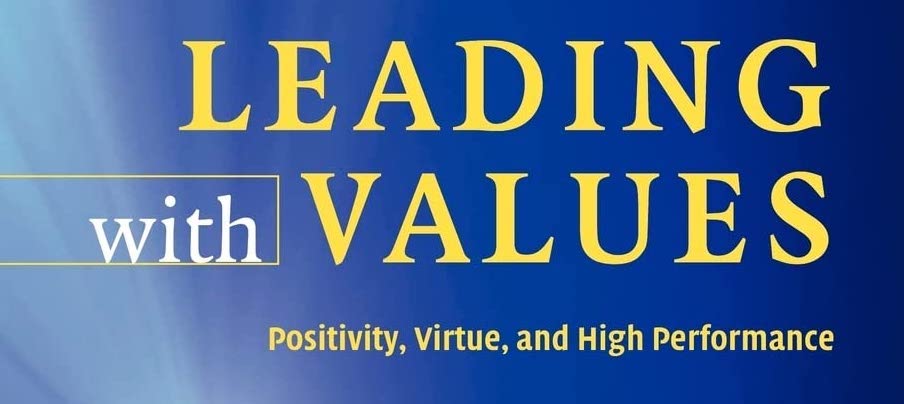Leading with Values: Positivity, Virtue and High Performance, published by Cambridge University Press in 2006, provides a collection of examples of leaders who focus on values and virtues to create and sustain highly successful organizations. The book consists of eleven chapters penned by different authors and highlighting the benefit of values-based leadership in different kinds of organizations. The editors, Edward Hess and Kim Cameron, selected the examples to help others adapt various lessons to their own leadership styles.
Chapter 1 emphasizes the value of taking care of one’s employees. It discusses Synovus Financial Services Corporation, which employs a systems-wide approach to values-based leadership to achieve success. The chapter illustrates several critical precepts, including the following: organizations can achieve great financial success while valuing its employees; maintaining a values-based culture is hard work; leaders must model right values; and good values should be rewarded and deviations should be addressed. At Synovus, “[t]he value chain begins with people, with performance being necessary, but people coming first” (16). Correspondingly, the company’s culture is decidedly spiritual and familial. Employees are well-compensated for their commitment, allowed to do volunteer work during work hours, and encouraged to focus on customer relationships.
Chapter 2, titled “FedEx Freight: Putting people first,” was written by Gary Bouch, Senior Vice President of Operations and Transportation for FedEx Freight. Bouch discusses some of FedEx Freight’s history, including significant challenges that arose as a result of a merger. The difficulties led Bouch to reconsider the company’s values and helped the recognize that taking good care of people while expecting great performance from them is the key to corporate success because the organization’s corporate advantage resides with its people.
Chapter 3 presents findings based on the role of values in several studies of high reliability organizations (HROs) that have fewer accidents than their counterparts. HROs operate under extremely trying conditions and include organizations like nuclear power-generation plants, naval aircraft carriers, and wildland firefighting crews. In these organizations, core values, including reliability, sensemaking, mistake avoidance, and wisdom, provide direction for people in environments with high quotients of unknowable, unpredictable events. The author of this chapter astutely emphasizes that, in HROs, leaders focus their values on things that are disvalued as well as things that are valued.
Chapter 4 is the first of two chapters concerning the values of the Marine Corps. It highlights spirituality as a key element that helps Marine leaders do the “right thing.” The authors note that the spiritual environment within the Corp is a product both of its tradition and culture as well as individual Marines’ understanding of their roles. The chapter includes a brief description of five key elements in the Corps’ culture that provide a foundation for its high performance as an organization. The elements are expeditionary nature, focus on survival, strong sense of accountability, use of maneuver warfare, and readiness to use violence when appropriate. In this culture, individual Marines are led to experience reality “at a deeper level, or at a higher level of abstraction."
In Chapter 5, Hess briefly chronicles HomeBanc Mortgage Corporation’s quest to become America's most admired company. The residential mortgage lender, led by CEO Pat Flood, has chosen to be extraordinary, and, in pursuing this goal, values customers and employees over money. The company’s mission to enrich and fulfill lives by serving internally and externally while supporting the dream of home ownership, and its values are promulgated and reiterated via, among other things, its symbols, credo, education program, hiring process, new associate orientation, and associate recognitions. As a result, HomeBanc has been financially successful, has high employee satisfaction, and a great reputation.
Chapter 6 discusses the values-based leadership employed as everyday practice in the Physician Billing Unit of a hospital. The unit was selected for study because of its reputation for displaying extraordinary values and getting great results. The authors observe, discuss, and illustrate seven values-based practices employed by “Sarah,” the unit’s supervisor. These included practices of identity, engagement, participation, humanity, life, meaning, and play. The discussion of each practice includes a succinct quotation from Sarah describing the precept, followed by discussion and examples expounding upon it.
Chapter 7 presents the extraordinary success of the Kaiser Hill in cleaning up and decommissioning the Rocky Flats nuclear production facility. The task was unprecedented, and the challenges were daunting, yet the project was completed in 1/6 of the estimated time at 1/6 of the estimated cost. Cameron interviewed a broad spectrum of people involved with the project and described how ten abundance values were key to Kaiser Hill’s success. These values included the need for plural leadership, a purpose that extends beyond personal interests and individual lifetimes, and valuing the lessons of success above the lessons of failure.
Chapter 8 uses the notorious fraud involving Kenneth Lay and Enron as a case study in principled leadership. The question under consideration throughout is, “How can leaders lead with their principles in organizational situations that challenge their ability to act on those principles?” In short, the authors posit that, in the corporate context, leaders can easily adopt scripts that emphasize business objectives while excluding or marginalizing more socially responsible goals. The authors propose a three-step process for hedging against this danger that includes making moral and ethical considerations an explicit part of leadership, personal reflection on the alignment of personal and firm values, and using leadership skills to enliven values within the organization.
Chapter 9, “Forgiveness as an attribute of leadership,” addresses the relevance of forgiveness for leaders in organization. LTL Trucking, with its long history of difficult management-union relations, is used as an illustration. When the company’s senior leadership decided to pursue a cultural transformation, its management stopped viewing the union as a rival and started viewing it as a partner. This was beautifully illustrated by the transformed relationship between a manager named John and a union steward named Sam. The chapter also discusses begrudging, pragmatic, and transcendent levels of forgiveness. Transcendent forgiveness, which seeks positive outcomes from negative experiences, is recommended because it fosters positive emotionality.
Chapter 10, “Values and leadership in organizational crisis,” is unique because it concerns leadership in times of tragedy, where an organization’s core values and social fabric are tested. The authors discuss the trauma and response to a shooting rampage at a university and note that, in times of crisis, values-based leaders tend to go beyond their formal roles, build community collaboration, and lead others to safety because they are mindful of the circumstances and their opportunity to help others. These responses are not contingent on formal position. Anyone can be a values-based leader by reaching out under circumstances where one’s natural tendency would be inwardly focused.
Chapter 11, “Making ‘more Mike Stranks’: teaching values in the United States Marine Corps,” is the second chapter in Leading with Values pertaining to the Marine Corps. The author considers the Corps’ need for leaders, particularly in light of its maneuver warfare fighting style. The style requires that every Marine understand the organizational goals and be able to pursue those goals at times when communication with superior officers is impeded or impossible. This works for the Corps because Marines trust one another, communicate with one another, and operate cohesively based on the common core values of honor, courage, and commitment. These values are developed, instilled, and reinforced, among other ways, in the recruiting process, in training, with positive peer pressure, through a professional reading program, and via mentoring.
Leading with Values is a continuing education tool for established leaders. Those with solid backgrounds in leadership will likely benefit most from the diversity of fields and finer points addressed in this book. The material can help a leader refine and improve his or her thinking about leading with values. It does not, however, address the nuts of bolts of the matter. Instead, it assumes readers already understand leadership and the role of values in leadership.

